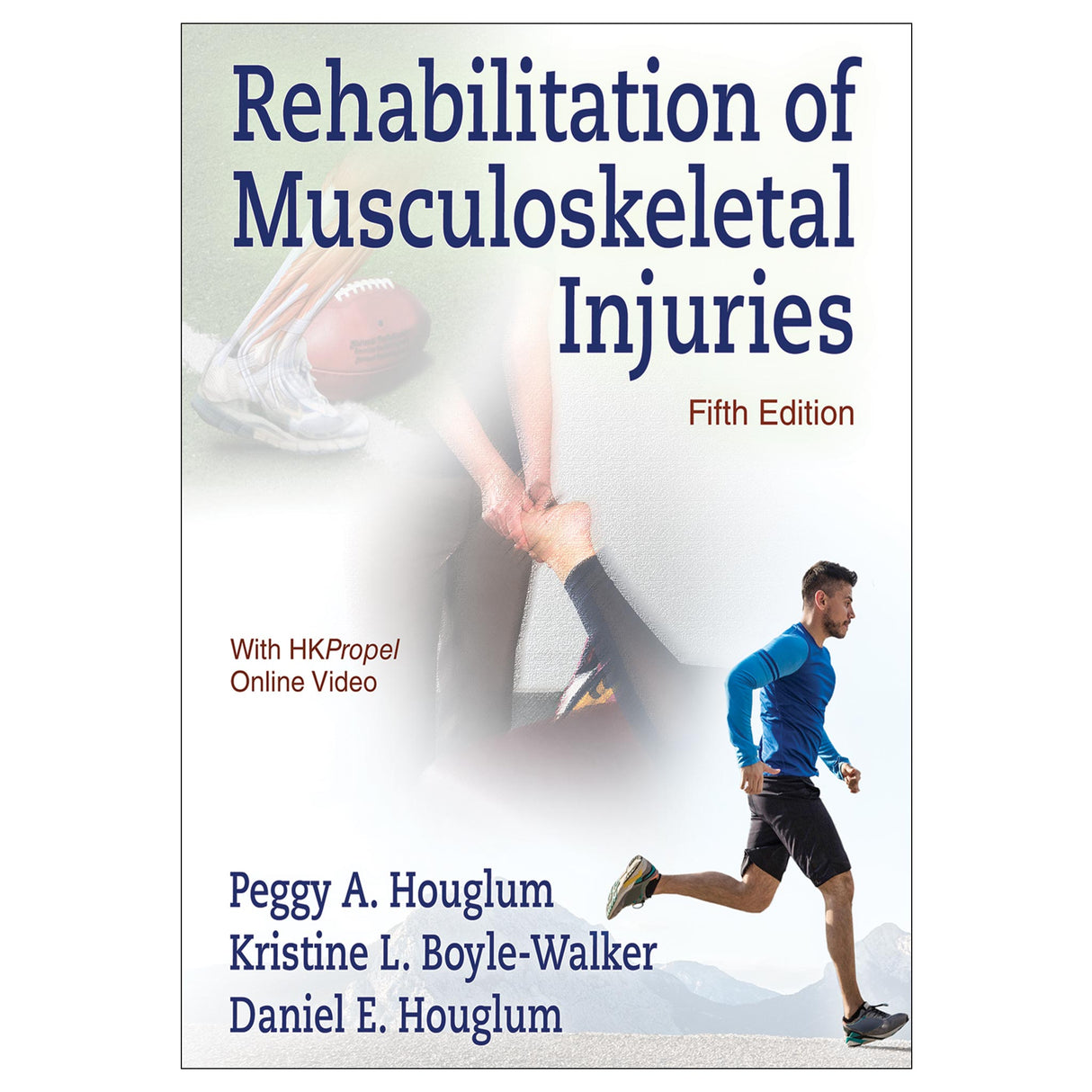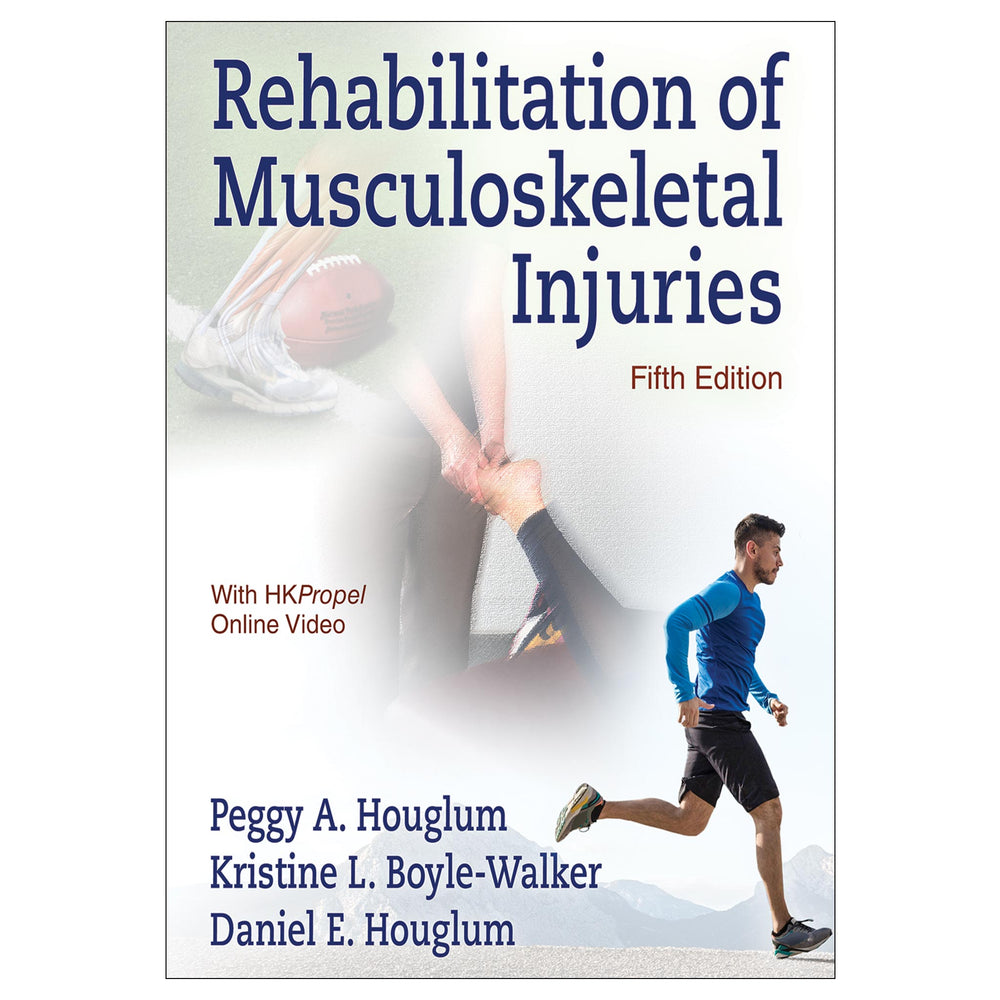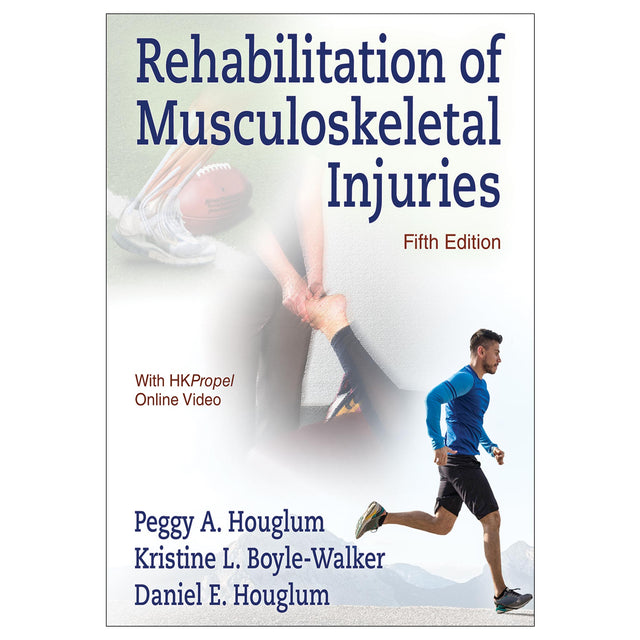Rehabilitation of Musculoskeletal Injuries 5th Edition With HKPropel Online Video
$244.95 CAD
Titled Therapeutic Exercise for Musculoskeletal Injuries in previous editions, the revised title supports the advancement of the field and better reflects the concepts and understanding of total rehabilitation of the patient. The content featured in Rehabilitation of Musculoskeletal Injuries aligns with the accreditation standards of the Board of Certification (BOC) and prepares students for the BOC athletic trainers’ exam. Respected clinician Peggy A. Houglum, who has more than 50 years of experience in the field, leads the expert author team to provide evidence-based perspectives, updated theories, and real-world applications. The latest edition is enhanced with contributions from new authors Daniel E. Houglum and Kristine L. Boyle-Walker, who have over 54 combined years of experience as athletic trainers, physical therapists, and instructors.
The fifth edition of Rehabilitation of Musculoskeletal Injuries places a greater emphasis on higher-order skills. Although it continues to present therapeutic exercise interventions, added content includes the other aspects of rehabilitation that would be applied to patients in clinical situations, including therapeutic interventions of modalities. Specific aspects of examination that are necessary to designing a rehabilitation program are also included. This edition also includes a new section on joint manipulation and a new chapter on functional adaptations in rehabilitation that focuses on providing emotional support as well as physical support in helping patients return to activities of daily living. Video content is expanded with 11 new clips that highlight therapeutic techniques, and more than 450 color photos and 750 illustrations help to enhance comprehension and clarify complicated concepts.
Rehabilitation of Musculoskeletal Injuries, Fifth Edition, provides thorough coverage of healing concepts, examination, and assessment techniques, ensuring students move from a solid understanding of the foundational skills and knowledge required of clinicians to comprehension of advanced problem-solving skills to make reliable rehabilitation decisions. The text demonstrates how to create rehabilitation programs using various modalities, manual therapy, and therapeutic exercise, and it highlights special considerations and applications for specific body regions.
Learning aids include case studies that emphasize practical application, Evidence in Rehabilitation sidebars that focus on peer-reviewed research and its practical application, and Clinical Tips that illustrate key points in each chapter. Additional learning aids include chapter objectives, lab activities, key terms, critical thinking questions, and references. For maximum flexibility to match course needs, instructors wanting to teach specific topics can adopt particular chapters or sections of the book through the Human Kinetics custom ebook program.
Note: A code for accessing online videos is included with all new print books.
Audience
Textbook for students in athletic training, physical therapy, and athletic injury prevention and rehabilitation programs. Reference for athletic trainers, sports medicine practitioners, physical therapists, and physiotherapists.Chapter 1. Introduction to Rehabilitation
Definition of Rehabilitation
Personal Issues
Objectives
Elements of Rehabilitation
Components of Rehabilitation
Phases of Rehabilitation
Clinical Practice
Evidence-Based Practice and Outcomes-Based Practice
Summary
Learning Aids
Chapter 2. Concepts of Healing
Primary and Secondary Healing
Healing Phases
Growth Factors
Healing of Specific Tissues
Tensile Strength During Healing
Factors That Affect Healing
Summary
Learning Aids
Chapter 3. Impact of Healing on Rehabilitation
The Three Rs of Rehabilitation
Timing of Rehabilitation Through the Healing Phases
Timing of Treatment Response
Summary
Learning Aids
Chapter 4. Age Considerations in Rehabilitation Plan and Program Design
Activity Levels, Stages of Life, and Health Care
Pediatric Considerations
Geriatric Considerations
Summary
Learning Aids
Part II. Examination and Assessment
Chapter 5. Overall Progression of Examination Procedures for Rehabilitation
Subjective and Objective Examination: Making a Profile
Interpreting Results and Designing a Rehabilitation Program
Record Keeping and Documentation
Summary
Learning Aids
Chapter 6. Posture
Posture
Muscle Imbalances
Summary
Learning Aids
Chapter 7. Gait Cycle and Ambulation Aids
Normal Gait
Clinical Gait Analysis
Pathological Gait
Normal Running Gait
Mechanics of Ambulation With Assistive Devices
Summary
Learning Aids
Chapter 8. Functional Adaptations in Rehabilitation
Specific ADL Considerations
Specific ADL Modifications
Summary
Learning Aids
Part III. Rehabilitation Tools
Chapter 9. Modalities
Modality Decisions in Rehabilitation
Modality Categories in Rehabilitation
Summary
Learning Aids
Chapter 10. Aquatic Rehabilitation Exercise
Physical Properties and Principles of Water
Indications, Advantages, Precautions, and Contraindications
Aquatic Rehabilitation Principles and Guidelines
Deep-Water Exercise
Aquatic Rehabilitation Exercises
Summary
Learning Aids
Lab Activities
Chapter 11. Manual Therapy
Critical Analysis
Massage
Myofascial Release
Myofascial Trigger Points
Muscle Energy
Proprioceptive Neuromuscular Facilitation
Other Manual Therapies
Joint Mobilization and Manipulation
Summary
Learning Aids
Chapter 12. Range of Motion and Flexibility Rehabilitation
Defining Flexibility and Range of Motion
Connective-Tissue Composition
Effects of Immobilization on Connective Tissue
Effects of Remobilization on Connective Tissue
Connective Tissue Mechanical Properties and Behavior in Range of Motion
Neuromuscular Influences on Range of Motion
Determining Normal Range of Motion
Range-of-Motion Activities
Stretching Techniques
Exercise Progression
Special Considerations With Stretching
Summary
Learning Aids
Chapter 13. Muscle Strength and Endurance
Neurological Structure and Function
Muscle Structure and Function
Muscles of the Body
Types of Muscle Fibers and Muscles
Muscle Strength and Power, Endurance and Recovery Related to Rehabilitation
Muscle Recruitment
Types of Muscle Activity
Open and Closed Kinetic Chain Activity
Strength Program Design
Programs of Goal Progressions
Summary
Learning Aids
Chapter 14. Neuromotor Control and Proprioception
Neurophysiology of Proprioception
Central Nervous System Proprioceptor Sites
Balance
Coordination
Agility
Rehabilitation Exercises for Proprioception
Summary
Learning Aids
Chapter 15. Functional and Performance-Specific Development
Definitions, Goals, and Foundations
Plyometric Exercises
Plyometric Program Considerations
Plyometric Precautions and Contraindications
Equipment for Plyometric Activities
Lower-Extremity Plyometrics
Upper-Extremity and Trunk Plyometrics
Rehabilitation Progression From Plyometrics to Functional to Activity-Specific Exercises
Functional-Level Exercise Basics
Functional and Performance-Specific Exercises
Examples of Functional Performance-Specific Progression
Final Step Before Full Return to Participation
Summary
Learning Aids
Chapter 16. Creating the Rehabilitation Program
Rehabilitation Program Contents
Phases of Rehabilitation
Individualization of a Rehabilitation Program
Summary
Learning Aids
Part IV. Rehabilitation of Body Segments
Chapter 17. Spine and SI Joint
Special Rehabilitation Considerations
Special Sacral, Ilial, and Pelvic Considerations
Body Mechanics
Examination of the Spine and Sacroilium
Rehabilitation Interventions
Special Rehabilitation Applications
Summary
Learning Aids
Chapter 18. Hip
Special Rehabilitation Considerations
Rehabilitation Interventions
Special Rehabilitation Applications
Summary
Learning Aids
Chapter 19. Knee and Thigh
Special Rehabilitation Considerations
Rehabilitation Interventions
Special Rehabilitation Applications
Summary
Learning Aids
Chapter 20. Foot, Ankle, and Leg
Special Rehabilitation Considerations
Common Structural Deformities
Orthotic Intervention for Foot Deformities
Determining Proper Footwear for Patients
Rehabilitation Interventions
Special Rehabilitation Applications
Summary
Learning Aids
Chapter 21. Shoulder and Arm
Specific Rehabilitation Considerations
Rehabilitation Interventions
Specific Rehabilitation Applications
Summary
Learning Aids
Chapter 22. Elbow and Forearm
Special Rehabilitation Considerations
Rehabilitation Interventions
Special Rehabilitation Applications
Summary
Learning Aids
Chapter 23. Wrist and Hand
Special Rehabilitation Considerations
Rehabilitation Interventions
Special Rehabilitation Applications
Summary
Learning Aids
Physical properties and principles of water and aquatic exercise
See how the muscles work to create ambulation




All ancillaries are free to adopting instructors through HKPropel.
Instructor guide. Includes chapter outlines and suggested lecture structures to aid instructors in lecture preparation. Also includes student activities for the classroom to facilitate learning and engagement with the materials.
Test package. Contains questions in true-false, fill-in-the-blank, essay and short-answer, and multiple-choice formats. The files may be downloaded for integration with a learning management system or printed for use as paper-based tests. Instructors may also create their own customized quizzes or tests from the test bank questions to assign to students directly through HKPropel. Multiple-choice and true-false questions are automatically graded, and instructors can review student scores in the platform.
Chapter quizzes. Contains ready-made quizzes (9-10 questions each) to assess student comprehension of the most important concepts in each chapter. Each quiz may be downloaded or assigned to students directly through HKPropel. The chapter assessments are automatically graded, and instructors can review student scores in the platform.
Presentation package. Features more than 350 PowerPoint slides of information from the book that can be used for class discussion and presentation. The slides in the presentation package can be used directly within PowerPoint or printed to make handouts for students. Instructors can easily add, modify, and rearrange the order of the slides.
Image bank. Includes most of the figures, content photos, and tables from the text, sorted by chapter. These can be used in developing a customized presentation based on specific course requirements.
Instructors also receive access to all student materials in HKPropel. For Rehabilitation of Musculoskeletal Injuries, this includes 47 video clips demonstrating rehabilitation and exercise techniques. Videos can be used as classroom supplements, learning aids, and reference material in a clinical setting.






